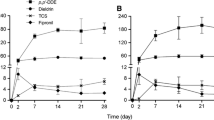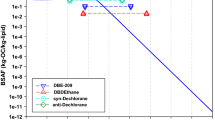Abstract
At contaminated sediment sites, the bioavailability of contaminants in sediments is assessed using sediment-bioaccumulation tests with Lumbriculus variegates (Lv). The testing protocols recommend that ratio of total organic carbon (TOC) in sediment to L. variegatus (dry weight) (TOC/Lv) should be no less than 50:1. Occasionally, this recommendation is not followed, especially with sediments having low TOC, e.g., <1 %. This study evaluated the impacts and resulting biases in the testing results when the recommendation of “no less than 50:1” is not followed. In the study, seven sediments were tested with a series of TOC/Lv ratios that spanned the recommendation. With increasing loading of organisms, growth of the organisms decreased in six of the seven sediments tested. Residues of polychlorinated biphenyls (PCBs) in the L. variegatus were measured in six of the seven sediments tested, and differences in PCB residues among loading ratios across all sediments were small, i.e., ±50 %, from those measured at the minimum recommended ratio of 50:1 TOC/Lv. In all sediment, PCB residues increased with increasing loading of the organisms for the mono-, di-, and tri-chloro-PCBs. For tetra-chloro and heavier PCBs, residues increased with increasing loading of organisms for only two of the six sediments. PCB residues were not significantly different between TOC/Lv loadings of 50:1 and mid-20:1 ratios indicating that equivalent results can be obtained with TOC/Lv ratios into the mid-20:1 ratios. Overall, the testing results suggest that when testing recommendation of 50:1 TOC/Lv is not followed, potential biases in the biota-sediment accumulations factors from the sediment-bioaccumulation test will be small.



Similar content being viewed by others
References
American Society for testing and Materials (2010) ASTM E1688—10ss Standard guide for determination of the bioaccumulation of sediment-associated contaminants by benthic invertebrates. ASTM, West Conshohocken
Ankley GT, Cook PM, Carlson AR, Call DJ, Swenson JA, Corcoran HF et al (1992) Bioaccumulation of PCBs from sediments by oligochaetes and fishes: Comparison of laboratory and field studies. Can J Fish Aquat Sci 49:2080–2085
Benoit DA, Phipps GL, Ankley GT (1993) A sediment testing intermittent renewal system for the automated renewal of overlying water in toxicity tests with contaminated sediments. Water Res 27:1403–1412
Billa N, Hubin-Barrows D, Lahren T, Burkhard LP (2014) Evaluation of micro-colorimetric lipid determination method with samples prepared using sonication and accelerated solvent extraction methods. Talanta 119:620–622
Burkhard LP, Hubin-Barrows D, Billa N, Highland TL, Hockett JR, Mount DR et al (2015) Sediment bioaccumulation test no. with Lumbriculus variegatus: Effects of feeding. Arch Environ Contam Toxicol 68:696–706
Fisher SW, Chordas SW III, Landrum PF (1999) Lethal and sublethal body residues for PCB intoxication in the oligochaete, Lumbriculus variegatus. Aquat Toxicol 45:115–126
Gustavo González A, Ángeles Herrador M (2007) A practical guide to analytical method validation, including measurement uncertainty and accuracy profiles. Trends Anal Chem 26:227–238
Kukkonen J, Landrum PF (1994) Toxicokinetics and toxicity of sediment-associated pyrene to Lumbriculus variegatus (oligochaeta). Environ Toxicol Chem 13:1457–1468
Lotufo GR, Farrar JD, Bridges TS (2000) Effects of exposure source, worm density, and sex on DDT bioaccumulation and toxicity in the marine polychaete Neanthes arenaceodentata. Environ Toxicol Chem 19:472–484
Mac MJ, Edsall CC, Hesselberg RJ Jr, Sayers R (1984) Flow-through bioassay for measuring bioaccumulation of toxic substances from sediment. EPA 905/3-84-007. Great Lakes National Program Office, USEPA
Mac MJ, Noguchi GE, Hesselberg RJ, Edsall CC, Shoesmith JA, Bowker JD (1990) A bioaccumulation bioassay for freshwater sediments. Environ Toxicol Chem 9:1405–1414
Mount DR, Dawson TD, Burkhard LP (1999) Implications of gut purging for tissue residues determined in bioaccumulation testing of sediment with Lumbriculus variegatus. Environ Toxicol Chem 18:1244–1249
Organisation for Economic Co-operation and Development (2012) Test no. 305: Bioaccumulation in fish: Aqueous and dietary exposure. OECD Publishing
Phipps GL, Ankley GT, Benoit DA, Mattson VR (1993) Use of the aquatic oligochaete Lumbriculus variegatus for assessing the toxicity and bioaccumulation of sediment-associated contaminants. Environ Toxicol Chem 12:269–279
RStudio (2013) RStudio: integrated development environment for R (version 0.98.507) [computer software]. http://www.rstudio.org
United States Environmental Protection Agency (1994) Methods for measuring the toxicity and bioaccumulation of sediment-associated contaminants with freshwater invertebrates. EPA/600/R-94/024. Technical Report. USEPA, Washington, DC
United States Environmental Protection Agency (1996) Method 3660B Sulfur cleanup. Test no. Methods for evaluating solid wastes. EPA Method SW 846. USEPA, United States Government Printing Office, Washington, DC
United States Environmental Protection Agency (2000a) Methodology for deriving ambient water quality criteria for the protection of human health (2000). EPA-822-B-00-004. USEPA, Office of Water, Office of Science and Technology, Washington, DC
United States Environmental Protection Agency (2000b) Methods for measuring the toxicity and bioaccumulation of sediment-associated contaminants with freshwater invertebrates (2nd ed). EPA 600/R-99/064. USEPA, Office of Research and Development, Mid-Continent Ecological Division, and Office of Water, Office of Science and Technology, Duluth, MN, and Washington, DC
United States Environmental Protection Agency (2008) Method 1668B, Chlorinated biphenyl congeners in water, soil, sediment, biosolids, and tissue by HRGC/HRMS, November 2008. EPA-821-R-08-020 USEPA, Office of Water, Office of Science and Technology, Washington, DC
United States Environmental Protection Agency/United States Army Corps of Engineers (1998) Evaluation of dredged material proposed for discharge in waters of the U.S.—Testing manual. Inland testing manual. EPA-823-B-98-004. USEPA, Office of Water, Office of Science and Technology/USACE, Operation, Construction, and Readiness Division
Van Geest JL, Watson-Lueng T (2013) Bioaccumulation of sediment-associated contaminants in freshwater organisms. Ontario Ministry of the Environment, Toronto
Van Geest JL, Poirier DG, Sibley PK, Solomon KR (2010) Measuring bioaccumulation of contaminants from field-collected sediment in freshwater organisms: a critical review of laboratory methods. Environ Toxicol Chem 29:2391–2401
Van Geest J, Poirier D, Solomon K, Sibley P (2011) The effect of organism density on bioaccumulation of contaminants from sediment in three aquatic test no. species: A case for standardizing to sediment organic carbon. Arch Environ Contam Toxicol 60:626–635
Van Handel E (1985) Rapid determination of total lipids in mosquitoes. J Am Mosq Control Assoc 1:302–304
Acknowledgments
We thank Guilherme Lotufo for comments on a draft of this manuscript. The manuscript has been subjected to review by the USEPA, National Health and Environmental Effects Research Laboratory, and approved for publication. The views expressed herein are those of the authors and do not necessarily reflect the views of policies of these agencies. Mention of trade names or commercial products does not constitute endorsement or recommendation for use.
Author information
Authors and Affiliations
Corresponding author
Electronic supplementary material
Below is the link to the electronic supplementary material.
Rights and permissions
About this article
Cite this article
Burkhard, L.P., Hubin-Barrows, D., Billa, N. et al. Sediment Bioaccumulation Test with Lumbriculus variegatus: Effects of Organism Loading. Arch Environ Contam Toxicol 71, 70–77 (2016). https://doi.org/10.1007/s00244-016-0284-6
Received:
Accepted:
Published:
Issue Date:
DOI: https://doi.org/10.1007/s00244-016-0284-6




